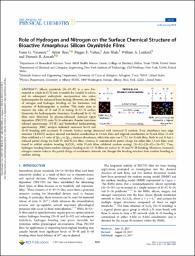
ATTENTION: The works hosted here are being migrated to a new repository that will consolidate resources, improve discoverability, and better show UTA's research impact on the global community. We will update authors as the migration progresses. Please see MavMatrix for more information.
Show simple item record
| dc.contributor.author | Varanasi, Venu | |
| dc.contributor.author | Ilyas, Azhar | |
| dc.contributor.author | Velten, Megen F. | |
| dc.contributor.author | Shah, Ami | |
| dc.contributor.author | Lanford, William A. | |
| dc.contributor.author | Aswath, Pranesh B. | |
| dc.date.accessioned | 2019-05-31T16:00:33Z | |
| dc.date.available | 2019-05-31T16:00:33Z | |
| dc.date.issued | 2017-08-21 | |
| dc.identifier.citation | Role of Hydrogen and Nitrogen on the Surface Chemical Structure of Bioactive Amorphous Silicon Oxynitride Films Venu G. Varanasi, Azhar Ilyas, Megen F. Velten, Ami Shah, William A. Lanford, and Pranesh B. Aswath The Journal of Physical Chemistry B 2017 121 (38), 8991-9005 DOI: 10.1021/acs.jpcb.7b05885 | en_US |
| dc.identifier.issn | 1520-6106 | |
| dc.identifier.other | ESSN: 1520-5207 | |
| dc.identifier.uri | http://hdl.handle.net/10106/28179 | |
| dc.description | The original publication is available at https://pubs.acs.org/doi/10.1021/acs.jpcb.7b05885 | en_US |
| dc.description.abstract | **Please note that the full text is embargoed** ABSTRACT: Silicon oxynitride (Si–O–N) is a new biomaterial in which its O/N ratio is tunable for variable Si release and its subsequent endocytotic incorporation into native hydroxyapatite for enhanced bone healing. However, the effect of nitrogen and hydrogen bonding on the formation and structure of hydroxyapatite is unclear. This study aims to uncover the roles of H and N in tuning Si–O–N surface bioactivity for hydroxyapatite formation. Conformal Si–O–N films were fabricated by plasma-enhanced chemical vapor deposition (PECVD) onto Ti/Si substrates. Fourier transform infrared spectroscopy (FTIR) and Rutherford backscattering spectrometry (RBS) analysis indicated increased Si–H and N–H bonding with increased N content. Surface energy decreased with increased N content. X-ray absorbance near edge structure (XANES) analysis showed tetrahedral coordination in O-rich films and trigonal coordination in N-rich films. O-rich films exhibited a 1:1 ratio of 2p3/2 to 2p1/2 electron absorbance, while this ratio was 1.73:1 for N-rich films. Both Si and N had a reduced partial charge for both O- and N-rich films, whereas O maintained its partial charge for either film. O-rich films were found to exhibit random bonding SizOxNy, while N-rich films exhibited random mixing: [Si–Si]–[Si–O]–[Si–N]. Thus, hydrogen bonding limits random nitrogen bonding in Si–O–N films via surface Si–H and N–H bonding. Moreover, increased nitrogen content reduces the partial charge of constituent elements and changes the bonding structure from random bonding to random mixing. | en_US |
| dc.language.iso | en | en_US |
| dc.publisher | American Chemical Society | en_US |
| dc.subject | Silicon oxynitride | en_US |
| dc.subject | Thin films | |
| dc.title | Role of Hydrogen and Nitrogen on the Surface Chemical Structure of Bioactive Amorphous Silicon Oxynitride Films | en_US |
| dc.type | Article | en_US |
Files in this item
- Name:
- JPCB varanasi 2017.pdf
- Size:
- 6.360Mb
- Format:
- PDF
This item appears in the following Collection(s)
Show simple item record


